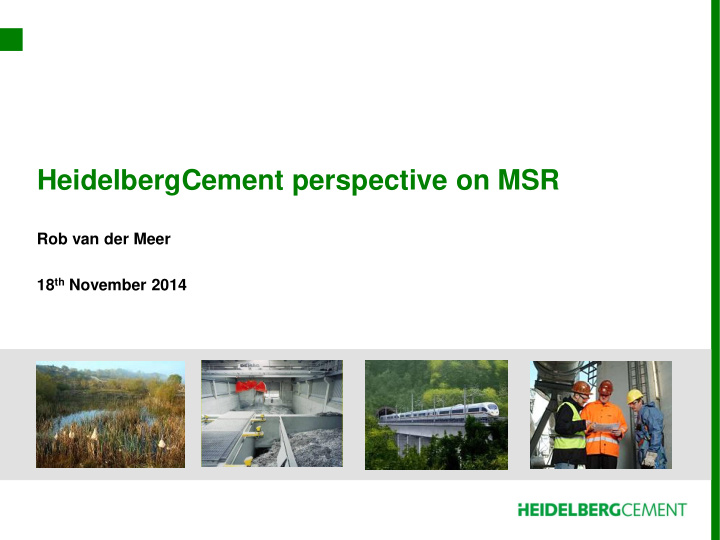



HeidelbergCement perspective on MSR Rob van der Meer 18 th November 2014 Slide 1 Global Environmental Sustainability
HeidelbergCement position on MSR proposal Challenges associated with the MSR proposal: – MSR brings artificial reduction of the cap until 2030 with heavy consequences The average of volumes which go into the reserve in the period 2021-2030 (196m) translates in a CO 2 reduction target of 50% in 2030 (compared to 43% in legislation) The Linear Reduction Factor would increase to 3.08% (from 1,74% changed to 2.2% in 2020) Cement industry: This is technologically not feasible and increases carbon leakage risks in light of already reduced free allocation of 2.2% per year after 2020 – Utilities sector’s forward hedging is bigger than MSR’s proposed upper treshhold – The MSR acts with too much delay leading to an less predictable carbon price MSR’s reaction delay of 2 years might lead to price volatility in the years in between – The MSR proposal does not tackle the issues of over-allocation and carbon leakage The issues of carbon leakage and free allocation (dynamic allocation ????) should be tackled in a holistic proposal for phase 4 The MSR is a good idea but it should: 1. Not lead to long term effective change in the cap. 2. Should lead to higher stability of the prices, also short term. 3. Should be discussed in conjunction with further reform options Slide 2 - June 2011 Slide 2 – 18/11/2014 Global Environmental Sustainability Rob van der Meer
Impacts of Different MSR Designs on Carbon Price Slide 3 – 18/11/2014 Rob van der Meer
CO 2 -reduction in cement sector [Kg/tcemt] EU ETS sector reduction target for 2030: -43% compared to 2005! Industry’s carbon leakage risk increases with new reduction target and artificial cap due to MSR Slide 4 – 18/11/2014 Rob van der Meer
Cement sector hedging approach in light of MSR 3. Pro-active - Regular and longer term emissions forecast Level of trading maturity - Trading based on emissions & price view (timing flexible) - Banking/borrowing between years 2. Reactive - Longer term outlook / hedging - Irregular and near term - Offset use emissions forecasts - Yearly trading activity (year end/ Q1) - Minimal banking/borrowing - Price neutral approach - Offset use 1. Passive - 1/yr emissions verification - Passive banking unused EUAs Evolution of hedging approach - Some ad-hoc selling during phases 3 and 4 - No offset use Development of EU ETS Slide 5 – 18/11/2014 Rob van der Meer
Regulatory uncertainty in EU ETS – The example of the Discussion regarding Backloading and MSR Q1 2014: – COM, Council and EP support „backloading proposal“ including release of backloaded allowances to market in 2019 and 2020 – COM proposes MSR starting 2021 Q3 2014: – COM starts changing perspective on MSR start date and return of backloaded allowances – EP ENVI starts discussion on transfer of backloaded allowances into MSR or cancelling of backloaded allowances – Individual MS lobby for early start and table own proposals for MSR including the direct transfer of backloaded allowances into MSR Q4 2014 – Director-General Jos Delbeke openly prefers early start of MSR and thinks about direct tranfer of backloaded allowances into MSR Backloading and MSR discussions exemplify huge regulatory uncertainty surrounding EU ETS Slide 6 – 18/11/2014 Rob van der Meer
Timeline of changes in the EU ETS 2005 Start of Phase I 2005 2005 Most NAPs approved 2006 Additional NAPs approved 2006 2006 New targets for NAPs phase 2 2007 Verdict on German ex post adjustments 2007 2008 Most NAPs approved 2008 2008 Connection of CITL & ITL after delay 2009 Change on CDM / JI emission rights 2009 2009 CCS directive adopted 2010 Benchmark decisions phase 3 2010 2011 Compensation for CO2 costs in electricity 2011 2011 NAPs 2 Poland and Estonia approved 2012 /2013 Backloading / Set aside discussion 2012 2013 Delay in allocation decision and allocations 2013 2013/2014 Structural reforms EU ETS 2013/2014 Re assessment carbon leakage 2014 New 2030 target 2014 Backloading with promise of return in 2019/2020 2014 2014 COM proposal for MSR starting in 2021 published 2014 COM promotes early start and transfer of allowances 2014/2015 Discussion of carbon leakage provisions post 2020 starts EU ETS regulatory uncertainty has continuously 2015 and creates difficult investment environment for industry
Recommend
More recommend